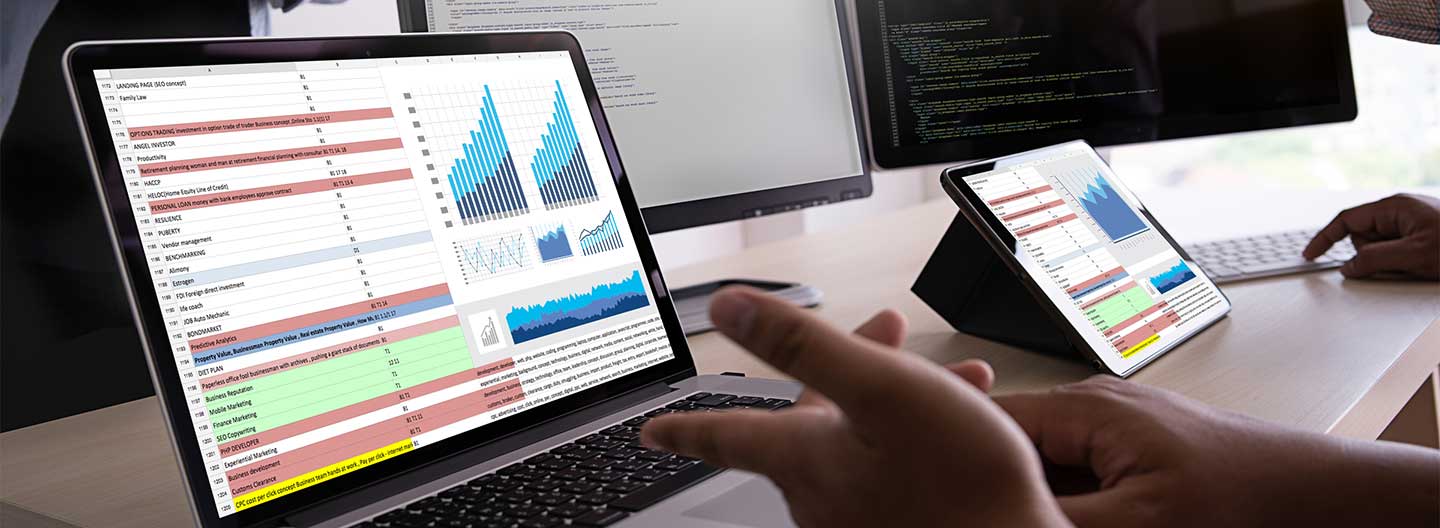Key performance indicators (KPIs) are metrics that provide insight into the performance of any given process or tool. When it comes to nonprofit websites, these metrics can help you determine how effective the site is at driving donations, volunteer sign-ups, awareness, or other organizational goals. With the proper tools, there is a wealth of data available regarding your website's performance.

How to Track Website Data
In order to generate a report, you will need to install an analytics tool on your website. If you use a content management system like Wix or Squarespace, some analytics may be available automatically. For custom-built sites on platforms like Drupal or WordPress, you'll need to select and install a tool to track this data. Google Analytics (GA) is a free tool that can be used on any website.
Once you have analytics installed, you can customize your dashboard to display KPIs that are critical for your organization. If you're not sure where to start, we recommend monitoring these three data points and related KPIs to get an accurate picture of your site's performance: traffic, behavior, and acquisitions.
Traffic: Sessions, Users, and Sessions per User
There are two metrics that indicate the volume of traffic to your website: sessions and users. Both of these help you to track growth in awareness of your organization.
Sessions
Sessions indicate the total number of visits to your website over the selected period of time. This includes traffic from all devices and can include repeat traffic from the same individuals.
Users
Unlike sessions, the Users metric reports the total number of unique individuals to visit your website over a given time period.
The difference between users and sessions gives you a general idea of how often users are coming back to your site on a regular basis. GA provides a related metric called Number of Sessions per User, which will tell you on average how many times an individual visited your site (sessions) over the selected time period. This will help you to understand how many new eyes you're getting on your website. Ideally, you want people to keep coming back to get updates or donate, but also a steady stream of people who are new to your organization.
Something to keep in mind when looking at your user data is the time period you have selected. If you're looking at one month, GA will consider each unique individual who visited that month as a user. However, if you open up the time range to one year, GA will only count that user one time for the whole year. It is important to look at user data for various time periods to identify trends.
Behavior: Page Views, Bounce Rate, and Time Spent on Page
Now that you know how many people are looking at your organization's site, you can go a bit deeper to look at how they are using the site. This will show you whether people are finding their way to the pages that you really want them to see, whether that is a donation or volunteer sign-up page or your latest annual report.
Page Views
Page Views tell you overall how many times a page on your site was viewed. At the top level, you can look at page views for your entire site, but you can also narrow this down by URL and see how many times a specific page or post was viewed. This is indicative of both popularity and ease of access to your content.
Bounce Rate
Bounce Rate is the percentage of sessions that entered and exited your site on a single page. It's difficult to draw conclusions from this metric when you're looking at the site overall, so it is important to drill down to the page level to view the bounce rate for individual URLs. If users are bouncing from your home page, that means they aren't engaging with the rest of your site. If they are bouncing from a volunteer interest form that you're linking to directly from an email or ad, that isn't necessarily a bad thing. It could indicate that you included everything they needed on that page to register. This is a metric that needs to be reviewed with the additional context in order to draw conclusions.
Time Spent on Page
The final key behavior KPI we recommend is Time Spent on Page. This metric tells you the average amount of time a user spent in a single session on that URL. It is a great indicator of how users are interacting with your content. You should develop a baseline of how long you think users would need to engage with a certain page and compare this to the actual data. For example, if you think it takes about two minutes to make a donation from your Support page, but the average time spent on the page is five minutes, that could indicate some user experience or technical difficulties that should be addressed.
Acquisition: Channels and Source
It's also useful to determine where your users come from. Knowing where your traffic is originating can help you better understand how to allocate resources to various outreach efforts and monitor their success. If you have not actively marketed your organization, this data can give you a great baseline to understand where traffic originates from naturally. When planning your marketing, you can make informed decisions about where you might need the most support.
Channels
Channels are the broadest set of acquisition data. Available channels are
- Organic search: Users who ended up on your website from an organic (unpaid) result on any search engine.
- Direct: Individuals who typed your website's URL directly into their browser.
- Social: Users who followed a link on any social media platform.
- Referral: A click from any other third-party website. This could be an online directory, a logo on a partner's website, a reference URL to your original content, or any number of other reasons your website would be listed elsewhere.
Source
If you want to get more specific information about where your traffic is coming from, you can also view acquisition by source. Source shows you the domain from which the user originated. This can provide further insight into what you learned from analyzing your top channels.
Getting Started
If you're in the process of developing a new website, you should plan to have analytics installed immediately after your site goes live so you can track KPIs from the very beginning. If you had Google Analytics on your old site, we recommend using the same account and tag on the new site so you can easily compare the data from both versions of the site. If you have a live site without analytics installed, don't worry! You can install GA at any time.
Our website team at TechSoup can help you get started and even run these reports for you on a regular basis. Get in touch with one of our website experts to get started!
Additional Resources
- Get started with Google Analytics with these two TechSoup Courses.
- See a webinar on Measuring What Matters with Google Analytics.
- Another webinar talks about How to Develop a Nonprofit Website Strategy for the Road Ahead.
- Get a free Website Wellness Assessment from TechSoup.
Top photo: Shutterstock








